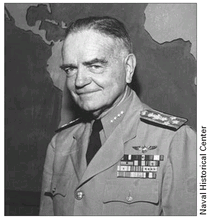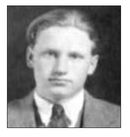War Stories II (18 page)
Authors: Oliver L. North

 USS HORNET
USS HORNETTASK FORCE 16.2
650 MILES OFF JAPANESE COAST
18 APRIL 1942
650 MILES OFF JAPANESE COAST
18 APRIL 1942
A 16mm film made by a U.S. Navy combat cameraman that stormy morning shows the deck crew pulling the wheel chocks from the lead B-25. Then, at 0820, with both engines at max rpm and sea spray whipping down the deck, Jimmy Doolittle's plane lumbered just a few hundred feet and leapt into the airâa dozen feet before reaching the end the
Hornet
's bow. The sailors on the flight deck let out a cheer. It could be done after all.
Hornet
's bow. The sailors on the flight deck let out a cheer. It could be done after all.
Doolittle's B-25 climbed immediately and circled, buzzed the
Hornet
to synchronize his magnetic compass heading with the ship's, and then headed west, while behind him the rest of the planes took off. One by one, the fifteen B-25s, each carrying 2,000 pounds of munitions, and nearly that much weight in fuel, along with five crewmen, followed Doolittle's example and took off.
Hornet
to synchronize his magnetic compass heading with the ship's, and then headed west, while behind him the rest of the planes took off. One by one, the fifteen B-25s, each carrying 2,000 pounds of munitions, and nearly that much weight in fuel, along with five crewmen, followed Doolittle's example and took off.
The first six did it flawlessly. The seventh planeâits flaps mistakenly left up in the pre-flight tensionâtook off but slipped dangerously low as it left the deck of the carrier, almost dropping into the waves. But the pilot recovered
in time and lifted his craft smoothly, up into the blustery skies with the rest of the bombers. The other nine B-25s followed without a hitchâalmost.
in time and lifted his craft smoothly, up into the blustery skies with the rest of the bombers. The other nine B-25s followed without a hitchâalmost.
Just before the last bomber cleared the deck, one of the sailors helping to launch the planes fell into the spinning prop of copilot Bob Hite and bombardier Jake DeShazer's B-25. Both men watched in horror as the blade tore off the sailor's arm, expecting that it had killed him. It wouldn't be until after the war that they would learn the sailor survived.
Â
Admiral William “Bull” Halsey commanded U.S. Navy carrier forces, and was later CINC South Pacific forces.

Doolittle had instructed his pilots that once they were airborne, they had to maintain course just forty feet above the ocean at a speed of 150 mph in order to conserve fuel. As the Army bombers headed west, Admiral Halsey ordered the
Hornet
, the
Enterprise
, and their escorts to make a sharp U-turn and head for Pearl Harbor. The Doolittle Raiders were now completely on their own.
Hornet
, the
Enterprise
, and their escorts to make a sharp U-turn and head for Pearl Harbor. The Doolittle Raiders were now completely on their own.

CORPORAL JACOB “JAKE” DESHAZER, USAAF
Plane #16, Doolittle Raid
18 April 1942
Plane #16, Doolittle Raid
18 April 1942

When Doolittle got up, we all let out a big cheer and we knew it could be done. In my B-25, Bill Farrow was the pilot and the copilot was Bobby Hite. George Barr was the navigator, Harold Spatz was crew chief, engineer, and gunner, and I was the bombardier. There were five men on each airplane, all doing the same kinds of duties. They told me that when our wheels left the deck of the
Hornet
, I became a sergeant.
Hornet
, I became a sergeant.
I really didn't know what was going to happen and I didn't speculate on it. I didn't think about it. If I got killed, I got killed.
 DOOLITTLE RAID
DOOLITTLE RAIDEN ROUTE TO TOKYO
550 MILES OFF JAPANESE COAST
18 APRIL 1942
550 MILES OFF JAPANESE COAST
18 APRIL 1942
The sixteen B-25s scattered in a loose formation spreading out more than 150 miles across the skies. To add to their fuel concerns, they were bucking a twenty-five miles per hour headwind. Soon they were out of sight of one another. That didn't matter, though. They had planned it this way. There was less likelihood of detection if they were spread out. They all had their own orders and flight plans; each aircraft had its own target list specifying where to drop its bombs.
A Japanese patrol plane at least 600 miles off the east coast of Japan spotted one of the bombers at 0945 and reported a single twin-engine, land-based plane flying toward the Home Islands. But back in Tokyo, the military intelligence people ignored the reportâit had to be a mistake; no land-based enemy aircraft that large could fly that far out to sea.
That morning in Tokyo there was a routine air raid drill. The military and civilians took it in stride. Practice drills were commonplace and the people often took them for granted. After all, Tokyo was safeâthe Japanese generals and Radio Tokyo had said so. And Emperor Hirohito had personally reassured them that they were safe from enemy attack. It was impossible for enemy aircraft to attack the city.
Just minutes after noon, the first of Doolittle's planes reached their target areas. Climbing to 1,500 feet to avoid being blown out of the sky by their own bombs, they lined up their targets in the bombsights.
At 1215, the Americans released their ordnance, and in fewer than fifteen minutes, Tokyo was ablaze from the B-25s' incendiary bombs.
The same thing happened in Osaka, Kobe, the Yokosuka Navy Yard, and three other Japanese cities. The raiders made it a point to seek out military targets, concentrating on factories believed to be serving the war effort, refineries, and docks, as well as any visible fuel and ammunition dumps.
After dropping their bombs, the B-25s descended to a hundred feet so as to present less of a target to Japanese anti-aircraft guns.
After dropping their bombs, the B-25s descended to a hundred feet so as to present less of a target to Japanese anti-aircraft guns.
The anti-aircraft fire was ineffective, and though enemy fighter planes were aloft and others were sent up during the raids, not one of the B-25s was shot down. Several Japanese fighters tried to close in on some of the U.S. aircraft after they had dropped their bombs, but it was no easy task. After hitting their targets, the Americans were squeezing every bit of speed they could out of their planes, achieving speeds of up to 300 mph. Those B-25s that were threatened responded with the only weapons Doolittle had let them keepâtwo lightweight .30-caliber machine guns. At least two Japanese fighters that got too close were downed.
For Doolittle and his raiders, escaping Japanese anti-aircraft batteries and fighters over land wasn't the end of their jeopardy. By the time they had cleared the west coast of Japan and headed over the East China Sea, the B-25s had enough fuel to fly about 800 miles. Unfortunately, the safe area in China was 1,000 miles away. But as the American aircrews began reviewing procedures for ditching at sea, something happened that seemed contrary to the laws of nature. A storm came up and the winds shifted. It seemed impossible to the navigators, who knew that the prevailing winds always blew from the China Sea toward Japan. But that day, the headwinds that they had bucked all day turned into tailwinds, and began to blow them toward China.
It was, in the minds of some of the weary airmen, an answer to prayerâa miracle! The winds were now helping the bombers to make up some of the hundreds of additional miles they had had to fly when they took off early from the
Hornet
.
Hornet
.
Still, the wind shift hadn't solved all their problems. None of the B-25s were able to pick up the homing signals in free China that were supposed to guide them to their recovery airfields. It was only later that they would learn that the plane dispatched to place the transmitting beacons had crashed in the same storm that helped extend the range of Doolittle's B-25s. Without those homing signals to guide them to friendly airfields, they were on their own.
Finally, nearly ten hours after they had bombed Japan, one by one, lost in a tropical storm, with fuel gauges at “empty,” their engines began to sputter. Doolittle's crew and the men aboard ten other B-25s decided that their best option was to bail out before the planes went down. Four other bombers made forced landings on the Chinese coast, but one crashed into the sea while trying to ditch. The plane hit the water at more than a hundred miles per hour, and the five men inside were pulled beneath the waves, still strapped in their seats. Three of them managed to unbuckle themselves and get out before the plane sank. These survivors managed to climb into a rubber life raft and make it to land. Soon after, the three were captured by Japanese patrols.
Only one plane was able to locate an airfield for a landingâbut that was because the pilot knew they wouldn't have enough fuel to get to China. He'd decided instead to head for Vladivostok, a Russian port in southeastern Siberia, some 500 miles west of Japan. When their B-25 landed, the Russians took the crewmen into custody and confiscated their bomber. Though the Soviets were ostensibly our “allies,” the American flyers were kept in Siberia until they escaped about a year later, eventually making their way through Iran to the Middle East and back into Allied hands.
The B-52 in which Jake DeShazer served as bombardier made it almost 300 miles into China. It wasn't far enough. He and the other four men on his plane parachuted safely from their doomed aircraft, but were soon captured. The Japanese wasted no time in parading the Americans before the cameras for propaganda purposes. In all, eleven of the Doolittle Raiders were captured and became Japanese POWs. Three of them, DeShazer's crewmates, were executed to exact revenge for the bombings. Jake DeShazer survived to tell the story.

Other books
Falling For The Player by Leanne Claremont
Captain Rakehell by Lynn Michaels
Growing Up Duggar by Jill Duggar
Write to Me by Nona Raines
Send the Snowplow by Lisa Kovanda
The Murder of Mary Russell by Laurie R. King
Trying to Survive (Part 3) by Crowley,C.J.
Tom Clancy's Ghost Recon: Combat Ops by David Michaels
Affairs of State by Dominique Manotti
